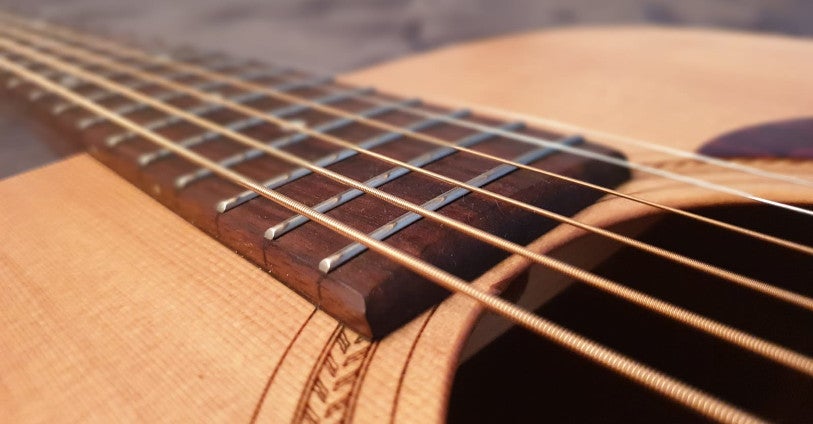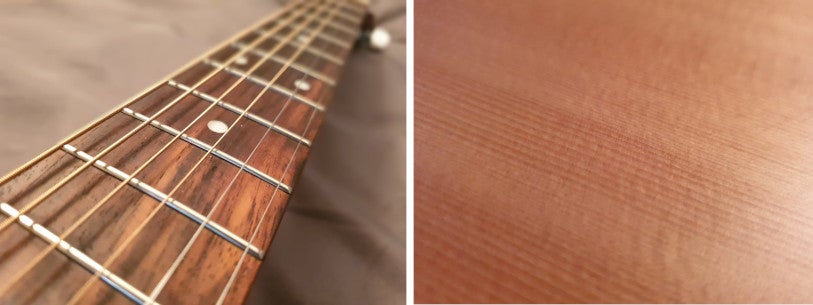Guitar Maintenance: Wood Conditioning, Temperature and Humidity
Published on Wednesday 21 July 2021
If you want your acoustic or electric guitar or bass to sound and feel as good as it possibly can, you can’t overlook the importance of proper maintenance. In this article, guest-blogger Dean explains how to nourish your instrument, how to keep the humidity in check and why the right room temperature is crucial.

- What’s Meant With ‘Instrument Health’?
- What Does Wood Conditioning Involve?
- Treating Other Parts With Oil
- The Negative Effects of Temperature and Humidity
- Ways to Counter Harmful Temperatures and Humidity Levels
- Hygrometer
- Humidifiers and Dehumidifiers
- Ambient Temperature
- Helpful Tools and Products
- Conclusion
- See Also
What’s Meant With ‘Instrument Health’?
When it comes to guitars and basses, instrument health mainly refers to the condition of the wood. Apart from a few special models made of materials like carbon-fibre, all guitars are mostly made of wood, which is naturally strong but also quite sensitive – especially if it’s been processed and used to craft delicate instruments. Fortunately, proper care and attention can mean a world of difference and result in improved playability and a more pure-and-transparent-sounding guitar. Next up, I’ll highlight a number of ways in which you can treat and maintain that special slab of tonewood your beloved instrument has been carved from.
What Does Wood Conditioning Involve?
One of the most important aspects of guitar maintenance is wood conditioning. In other words: keeping the wood ‘moist’ using natural oils. First and foremost, it’s about nourishing the fretboard with special oils that are free from ecologically harmful substances such as silicone. By conditioning the fretboard with the right oil, you not only prevent the wood from drying out but the neck from warping. Also, unconditioned fretboards tend to have a rougher feel which can make it more difficult to pull off slides. To refresh a fretboard, grab a clean microfibre cloth and simply rub a little oil into the wood while trying to avoid smearing any on the frets. Bear in mind that the oil is pretty greasy and can stick to your fingers for a quite while. Here’s a list of fretboard conditioners.
Please note:
- Since it can’t seep into the wood, fretboard oil shouldn’t be used on lacquered fretboards.
- Never use any lemon-based oils on maple fretboards!

Treating Other Parts with Oil
In some cases, you can also apply oil to other parts of your guitar. Since the body, neck, headstock, and the bridge (acoustic guitars only) are usually made of wood, these also dry out, affecting the foundation sound. As such, it’s imperative that you take care of every square inch of wood and, at the same time, remember that you should only condition any parts that aren’t coated in satin-gloss (matt finish) or high-gloss (shiny finish) lacquer so the oil can make its way into the wood. If you’re not sure about the finish on a specific part of your bass or guitar, always double-check the specifications! Also, don’t worry if there are parts of your guitar that can’t be treated with oil, because there are plenty of other ways you can keep your guitar in good nick!

The Negative Effects of Temperature and Humidity
The climate of the room your instrument is kept in also greatly affects its state and can lead to the instrument constantly dropping out of tune, a warped neck, and a shorter lifespan for the strings. All of these unwanted results obviously leave their mark on the overall playability. Here, room climate refers to the temperature, humidity and the amount of sunlight the instrument’s exposed to, all of which need to preferably be as consistent as possible. Guitars are best kept away from direct sunlight and prefer an ambient temperature between 17° and 21° Celsius and a humidity level that hovers around 50%.
There are a few scenarios to keep in mind here. During the cold Winter months, most homes are warmed through central heating which lowers humidity levels. On the flip side, the lucky few have access to air conditioning in the Summer when there’s more moisture in the air, but the point is that there’s a lot of factors at play that can affect the state of your instrument. High-quality components and high-end guitars can definitely counter any of these negative effects to a certain degree, but it’s worth knowing that in extremely dry, low-humidity situations,, guitar bodies can start showing cracks and bridges can even come popping right off.

Ways to Counter Harmful Temperatures and Humidity Levels
There are a number of ways you can keep the temperature and humidity under control to optimise the conditions your guitar or bass ‘lives’ in.
Hygrometer
First of all, I recommend using a digital hygrometer: a device designed to measure ambient temperatures and humidity levels. Most hygrometers store min/max values for eased monitoring, and a handful of weirdly-yet-welcomely extensive models even have a built-in alarm clock you can set to get to your gigs on time.
Check out Bax Music’s range of hygrometers!
Humidifiers and Dehumidifiers
In addition to a hygrometer, a humidifier is another solid investment you could make. Mains-powered humidifiers are equipped with a water tank and are designed to evaporate water before spreading the particles around the room to increase the amount of water in the air – the humidity level. Examples of affordable humidifiers include models by Medisana. What’s important to bear in mind when shopping for a humidifier are the options it offers to set custom values. In fact, being able to maintain a consistent humidity level of, say, 55% is not only healthy for your six-string (or 4,5,7,8,12,or x-string) side-kick, but for you and your respiratory tract! If it’s almost always too humid in your room, you may want to consider a dehumidifier instead. Both Trotec and Renkforce offer a nice selection of attainable models, where it’s important to keep in mind how much space any given dehumidifier can cover, which goes for humidifiers as well. Coverage is always included in the specifications and indicated in m² and m³, so make sure to pick a model that has enough capacity depending on the size of your room.
Ambient Temperature
Air-conditioning is as welcome as it is recommended during hot Summer days. While they offer a great way of keeping the ambient temperature in check, they do need a lot of electricity to work. If you’ve already got a hygrometer, set up your instrument in the coolest room in the house. Add a humidifier, and you can easily create a stable environment. During Winter, most homes are heated via central heating. If you’ve got a thermostat where you can set a consistent temperature, preferably per room, you already have access to a way of fixing a relatively stable atmosphere.
Helpful tools and Products
There are a few helpful bits of kit that can lend a helping hand to support the condition of the wood of your instrument(s). Bax Music stocks teeny-tiny, purpose-made humidifiers that can be secured inside the sound hole of acoustic instruments. Plenty of (large, online) retailers also offer inexpensive, reusable moisture absorbers, which usually have a two-piece plastic tray design consisting of a reservoir, or drip cup, and a part for the absorber.

Conclusion
Let’s recap:
- ‘Instrument health’ basically refers to the condition of the wood.
- The wood needs to be nourished and conditioned using special, natural-based seed oil. While the oil can be used to treat other parts, it’s usually only used to treat fretboards.
- Temperature and humidity can have devastating effects on instruments, since they can cause unstable tuning, warped necks, and cracks in the wood.
- Luckily, there’s ample ways to care for the wood, including humidifiers, dehumidifiers and hygrometers.
- Other helpful gear includes sound-hole humidifiers and moisture absorbers.
See Also
» Guitar Maintenance Gear
» Guitars Parts and Tools
» All Guitars and Accessories
» All Basses and Accessories
» What Do I Need to Clean My Guitar?
» Laminated, Solid Top or All-Solid Guitar?
» How to Replace or Adjust the Nut of Your Guitar
» How to Replace the Tuners of Your Guitar
» How to Connect a Guitar to a Computer
» Repair the Electronics of Your Electric Guitar Yourself? Really?!
» How To Change Electric Guitar Strings
» How To Change Acoustic Guitar Strings
» How To Replace Passive Electric Guitar Pickups
» How to Set Up an Electric Guitar
» How To Replace Classical Guitar Strings






